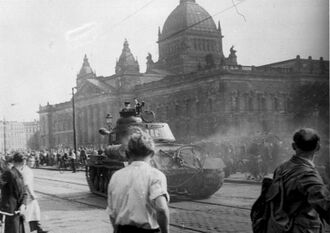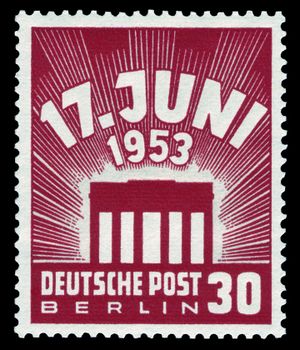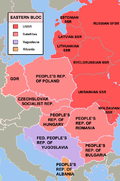انتفاضة 1953 في ألمانيا الشرقية
| East German uprising of 1953 | |||||||
|---|---|---|---|---|---|---|---|
| جزء من the Cold War and the Anti-communist insurgencies in Central and Eastern Europe | |||||||
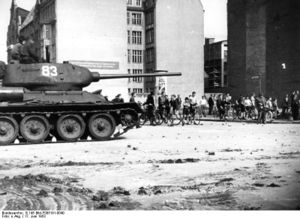 Soviet T-34-85 in East Berlin on 17 June 1953 | |||||||
| |||||||
| المتحاربون | |||||||
|
|
| ||||||
| القادة والزعماء | |||||||
| No centralized leadership | |||||||
| الوحدات المشاركة | |||||||
|
| None | ||||||
| القوى | |||||||
|
East Germany: 16 divisions Berlin:
| 1,000,000–1,500,000 demonstrators[2] | ||||||
| الضحايا والخسائر | |||||||
| 55–125+ killed[3] | |||||||
انتفاضة 1953 في ألمانيا الشرقية بدأت بإضراب قام به عمال الإنشاءات في برلين الشرقية في 16 يونيو. It began with a strike action by construction workers in East Berlin on 16 June against work quotas during the Sovietization process in East Germany. Demonstrations in East Berlin turned into a widespread uprising against the Government of East Germany and the Socialist Unity Party the next day, involving over one million people in about 700 localities across the country.[4] Protests against declining living standards and unpopular Sovietization policies led to a wave of strikes and protests that were not easily brought under control and threatened to overthrow the East German government. وانقلب إلى انتفاضة واسعة ضد حكومة جمهورية ألمانيا الديمقراطية في اليوم التالي.
الانتفاضة في برلين تم قمعها بعنف بواسطة مدرعات مجموعة القوات السوڤيتية في ألمانيا وفولكسپوليتساي. وعلى الرغم من تدخل القوات السوڤيتية، فإن موجة الاضرابات والاحتجاجات لم يتم السيطرة عليها بسهولة. وحتى بعد 17 يونيو، كانت هناك مظاهرات في أكثر من 500 بلدة وقرية.
انتفاضة 1953 كانت حدثاً يحتفى به في ألمانيا الغربية كعطلة عامة في 17 يونيو حتى إعادة توحيد ألمانيا في 1990، والتي بعدها حل محلها German Unity Day, celebrated annually on 3 October.[5]
خلفية
في يوليو 1952 انعقد المؤتمر الثاني للحزب (وهو أقل أهمية من المؤتمر العام للحزب) لأعضاء حزب الوحدة الاشتراكي (ألمانيا) (SED) وكان مقر انعقاده برلين الشرقية. وبكلمات ڤالتر اولبرخت، فكان يجب أن يوجد "تطبيق منهجي للاشتراكية" (planmäßiger Aufbau des Sozialismus)؛ وقد تم الاتفاق على أن عملية السڤيتة يجب أن ترتفع وتيرتها وتوسيع أهمية الدولة.
وقد عنى ذلك، على سبيل المثال، تفكيك الأربع ولايات إلى 14 منطقة (دائرة Bezirke) بالاضافة إلى برلين الشرقية، وأهم ما في ذلك، هو الهجوم على الطبقة الوسطى في ألمانيا الشرقية: المزارعون المالكون لأراضي، وكذلك أصحاب الأعمال الصغيرة/ورجال الحرف، الين كان يجب اجبارهم على التنازل عن استقلاليتهم عبر رسوم متصاعدة.
| الكتلة الشرقية |
|---|
 |
16 يونيو
An article in the trade union paper Tribune restated the necessity of the 10% work quota increases; evidently, the government was unwilling to retreat on the issue, despite the new quotas' widespread unpopularity.
At 9:00 AM on the morning of 16 June, 300 workers from the construction sites at "Hospital Friedrichshain" and "Stalinallee Block 40" in East Berlin went on strike and marched on the Free German Trade Union Federation (FDGB) headquarters on Wallstrasse, then to the city centre, hoisting banners and demanding a reinstatement of the old work quotas. Demands from the striking workers broadened to encompass political matters beyond the quotas. Via Alexanderplatz and Unter den Linden, most of the demonstrators moved to the government seat on Leipziger Straße; others went to SED headquarters on Wilhelm-Pieck-Straße. En route, they took over two sound trucks and used them to spread their calls for a general strike and a demonstration, set for the Strausberger Platz at 7:00 AM the next day. In front of the GDR House of Ministries, the rapidly growing crowd demanded to speak to Ulbricht and Grotewohl. Only Heavy Industry Minister Fritz Selbmann and Professor Robert Havemann, president of the GDR Peace Council, emerged from the building. Their attempts to calm the workers were drowned out by the clamour of the crowd, which shouted the pair down.[6]
17 يونيو
برلين الشرقية
Following Semyonov's decision, Soviet troops entered the environs of East Berlin in the early morning of 17 June. Meanwhile, crowds of workers began to gather at Strausberger Platz and other public places, and began marching towards the city centre. En route, they encountered GDR security forces – regular and Kasernierte Volkspolizei ('Barracked People's Police', KVP) units – who, apparently lacking instructions, did not initially intervene. Along with SED and FDJ functionaries, police officials tried – and mostly failed – to convince the marchers to return to their homes and workplaces. Where police attempted to halt or disperse the crowds, they rapidly ended up on the defensive. As the demonstrators drew in ever-greater numbers, a feeling of solidarity swept over them. Loudspeaker cars and bicycles provided communications between the different columns of marchers from the outer districts as, all morning, they converged on the city centre. On improvised banners and posters, the demonstrators again demanded the reinstatement of the old work quotas, but also price decreases, the release of fellow protestors arrested the day before, even free and fair all-German elections. Slogans like "down with the government!" and "butter, not arms" were also visible. Party posters and statues – especially those depicting SED and Soviet leaders – were burned or defaced.[بحاجة لمصدر]
By 9:00 AM, 25,000 people had gathered in front of the House of Ministries, and tens of thousands more were en route to Leipziger Strasse or in Potsdamer Platz. Between 10:00 and 11:00 AM, 80 to 100 demonstrators apparently stormed the government seat, visibly demonstrating that the 500 Volkspolizei and Stasi members had been overpowered.[7] Then, suddenly, Soviet military vehicles appeared, followed by tanks, to repel what appeared to be an immiment takeover. Within an hour, Soviet troops had cleared and isolated the area around the government headquarters. At noon, Soviet authorities terminated all tram and metro traffic into the Eastern sector and all but closed the sector borders to West Berlin to prevent more demonstrators from reaching the city centre. An hour later, they declared martial law in East Berlin.[7] Outside East Berlin police headquarters, Soviet tanks opened fire on "the insurgents". Fighting between the Soviet Army (and later GDR police) and the demonstrators persisted into the afternoon and night – with, in some cases, tanks and troops firing directly into the crowds. Executions, most prominently of West Berlin worker Willi Gottling, and mass arrests followed.
Overnight, the Soviets and the Stasi started to arrest hundreds of people. Ultimately, up to 10,000 people were detained and at least 32, probably as many as 40, were executed, including Soviet Army soldiers who refused to obey orders.[8] With the SED leadership effectively paralysed at the Soviet headquarters in Karlshorst, control of East Berlin passed to the Soviets there.[9]
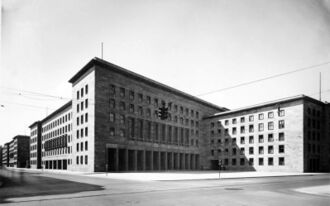
خارج برلين الشرقية
Each of East Germany's 24 cities with a population greater than 50,000 experienced upheavals, as did approximately 80% of the towns with populations between 10,000 and 50,000. Approximately 339,000 people participated in the 129 demonstrations that took place outside of Berlin; over 225,000 launched strikes in 332 factories. The main centres of protest included the industrial region around Halle, Merseburg, and Bitterfeld, as well as middle-size towns like Jena, Görlitz, and Brandenburg. No more than 25,000 people participated in strikes and demonstrations in Leipzig, but there were 32,000 in Magdeburg, 43,000 in Dresden, 53,000 in Potsdam – and in Halle, close to 100,000.[بحاجة لمصدر]
At first, such demonstrations were relatively peaceful, but as increasing numbers began to participate, they became more violent. Looting, particularly of SED-owned shops, became a regular occurrence; there was some arson, and many SED functionaries were beaten up later in the day. In some towns, the jails were seized by demonstrators, who demanded the release of certain political prisoners.[10] In Görlitz a group of 30,000 people destroyed the communist party headquarters, the offices of the secret police and the prison, while in Magdeburg the party headquarters and prison were set on fire.[11] When the Soviet Army intervened in these places outside of East Berlin, they seemed more restrained and more passive; some Soviet soldiers even displayed friendly attitudes towards demonstrators.[9]
In the countryside, meanwhile, protests took place in over 200 villages. However, many East German farmers did not take collective action against the regime: the most common expression of protest in rural areas was for farmers to leave and/or dissolve recently formed collective farms and resume farming on their own.[12]
Although the demands made by protesters could be political – e.g. the dissolution of the East German government and organisation of free elections – they were often simply of a local and economic character. They were about issues like bread shortages, unpopular night shifts, even the number of toilets in the workplace and the fact that tea was being served in rusty urns.[13] Also expressed were widely held grievances against the intelligentsia, who were perceived to enjoy 'unfair privileges', such as special deliveries of basic foodstuffs and other commodities.[14]
Others, particularly workers, demanded the restoration of the Social Democratic Party (SPD) in East Germany. Among former social democrats, there existed enormous bitterness against Prime Minister Otto Grotewohl, ex-leader of the East German SPD, whom they believed had "betrayed the SPD" by leading its merger with the rival German Communist Party to form the ruling SED in 1946. The Soviet Military Administration (SVAG) had pressured Grotewohl into the merger to protect communist rule in East Germany after the surprisingly poor performance of communist parties in elections in Hungary and Austria in November 1945. Grotewohl was "rewarded" with the post of Prime Minister, but within a few years the SED had significantly reduced his powers and turned the office into a mostly ceremonial role. Many East German social democrats viewed Grotewohl as a traitor who should now "have his neck wrung."[15]
ذكراها
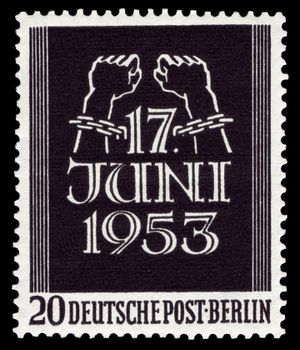
وقد خـُلـِّد الحدث في القصيدة التالية من برتولت برخت:
- الحل
- After the uprising of the 17th of June
- The Secretary of the Writers Union
- Had leaflets distributed in the Stalinallee
- Stating that the people
- Had forfeited the confidence of the government
- And could win it back only
- By redoubled efforts. Would it not be easier
- In that case for the government
- To dissolve the people
- And elect another?
كما تعامل مؤلفون بارزون آخرون في ألمانيا الشرقية مع الانتفاض، وكان منهم شتفان هايم (Fünf Tage im Juni / "خمسة أيام في يونيو", ميونخ 1974) وهاينر مولر (Wolokolamsker Chaussee III: Das Duell / "Volokolamsk Highway III: The Duel", 1985/86).
West German group Alphaville mention the date explicitly as "the seventeenth of June" but without reference to the year in their 1984 song "Summer in Berlin," from the album Forever Young. When the compilation album Alphaville Amiga Compilation was assembled for release in East Germany in 1988, the song "Summer in Berlin" was submitted for inclusion, but rejected "for political reasons."[16]
مسرحية گونتر گراس Die Plebejer proben den Aufstand / The Plebeians Rehearse the Uprising (1966) تعكس اعداد برخت لانتاج كوريولانوس لشيكسپير على خلفية أحداث 1953.
انظر أيضاً
- Poznań protests, June 1956
- Hungarian Revolution, October–November 1956
- Warsaw Pact invasion of Czechoslovakia, August 1968
- Tiananmen Square protests, April–June 1989
- Monday demonstrations in East Germany, September 1989–April 1991
- Romanian Revolution, December 1989
الهامش
- ^ "17. Juni 1953 — Chronik — Projektsite Bundeszentrale für politische Bildung, DeutschlandRadio, Zentrum für Zeithistorische Forschung".
- ^ Dale, Gareth (2005). Popular Protest in East Germany. Routledge. p. 9.
- ^ Jones, Timothy (2017). "Berlin marks East German uprising of 1953". DW News.
- ^ Alison Smale (June 17, 2013). "60 Years Later, Germany Recalls Its Anti-Soviet Revolt". The New York Times. Retrieved June 18, 2013.
- ^ Dale, Gareth. "East German rising 17 June 1953". academia.edu. Jacobin Magazine. Retrieved 18 June 2017.
- ^ Ostermann, 162
- ^ أ ب Ostermann, 164
- ^ "Of Flowers and Murder". Discover Magazine. Retrieved 18 June 2020. https://www.discovermagazine.com/planet-earth/of-flowers-and-murder
- ^ أ ب خطأ استشهاد: وسم
<ref>غير صحيح؛ لا نص تم توفيره للمراجع المسماةOstermann-2 - ^ Hutchinson, 369
- ^ Applebaum, Anne (2012). Iron Curtain: The crushing of Eastern Europe 1944-1956. p. 470.
- ^ Port, 124
- ^ Pritchard, 211
- ^ Ross, 56
- ^ Pritchard, 212
- ^ Alphaville Discography
المصادر
- Bibliographical Database of the International Literature on the Uprising of June 17, 1953 in the GDR
- Ulrich Mählert. Der 17. Juni 1953, ein Aufstand für Einheit, Recht und Freiheit. Berlin: J.H.W.Dietz, 2003.
- 1953: The East German uprising on libcom.org
- Alexandra Richie. Faust's Metropolis: a History of Berlin. New York: Carroll & Graf Publishers, 1998.
- Ann Tusa. The Last Division: a History of Berlin, 1945-1989. Reading, Massachusetts: Addison-Wesley, 1997.
- BBC: Berliner recalls East German uprising (by Ray Furlong)
- Der 16. Juni 1953 bleibt mir unvergesslich Eyewitness report by Peter Bruhn (in German)
- Hope M. Harrison. "Driving the Soviets up the Wall: Soviet-East German Relations, 1953-1961."
- Christian F Ostermann. ed., "Uprising in East Germany, 1953: The Cold War, the German Question, and the First Major Upheaval..." Central European University Press: 2003.
The East German Rising- Stefan Brant- Frederick A. Praeger, Inc. Ny, Ny 1957.
وصلات خارجية
- June 17, 1953: Personal memories of the strike leader and political prisoner Karl-Heinz Pahling
- The CWIHP at the Wilson Center for Scholars Document Collection on the 1953 East German Uprising
- A film clip 1953 anniversary of 1953 East Berlin uprising (1959) is available for free download at the Internet Archive [more]
- Short description is different from Wikidata
- Articles containing ألمانية-language text
- Articles with unsourced statements from August 2023
- Pages with empty portal template
- 1953 في ألمانيا
- 1953 في ألمانيا الشرقية
- مناهضة الشيوعية في ألمانيا
- تمردات الحرب الباردة
- نزاعات 1953
- شغب 1953
- الكتلة الشرقية
- العلاقات الألمانية السوڤيتية
- تاريخ ألمانيا الشرقية
- تاريخ برلين
- العلاقات الخارجية للاتحاد السوڤيتي
- احتجاجات في ألمانيا
- احتلالات سوڤيتية
- 1953 في العلاقات الدولية
- Protest-related deaths
- قتال شوارع
